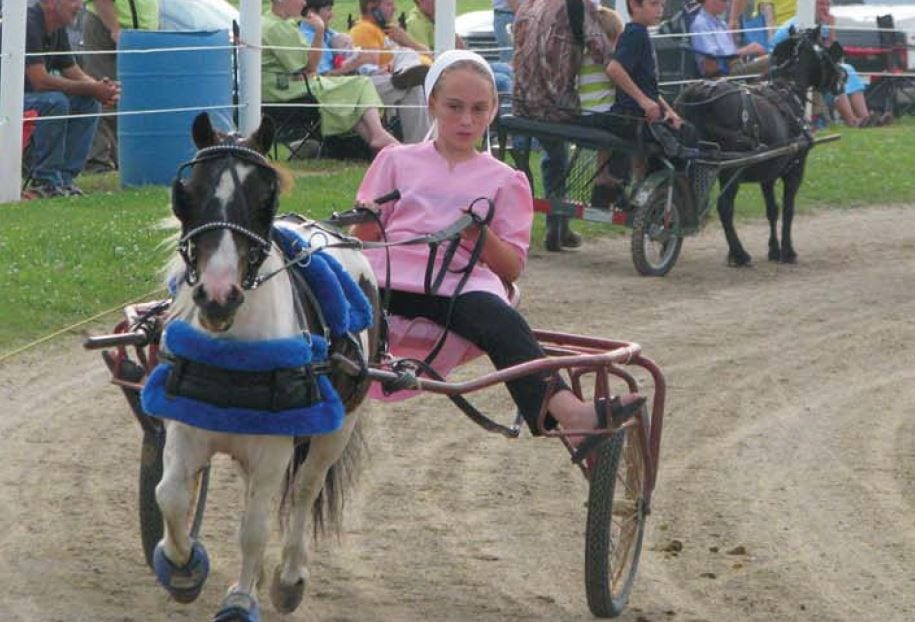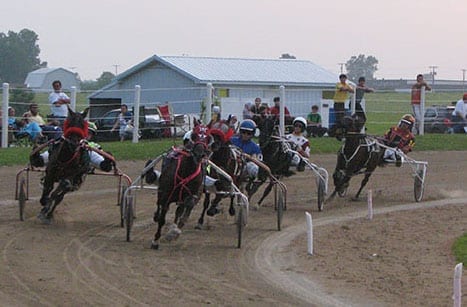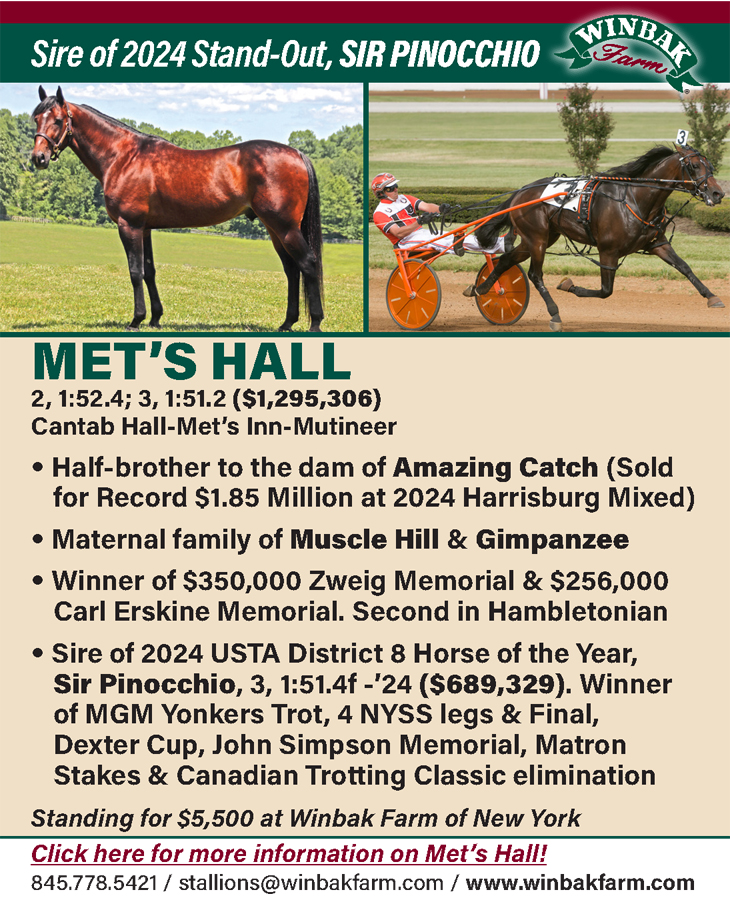At Nappanee Raceway, Little Horses Put On a Big Show
By Bill Finley
NAPPANEE, In–It’s a Monday night here in the heartland and all is quiet and peaceful, from the stillness of the cornstalks to the lonely, empty rural roads to the Amish buggies parked neatly in a row, the horses waiting patiently while the passengers tend to their business.
 It’s just what you’d expect from a place called Nappanee, Indiana, population 6,648, notable for being the home of Metzler’s Shoes, opened in 1924, and the Nappanee Apple Festival. The festival, by the way, features a seven-foot wide apple pie that weighs 600 pounds.
It’s just what you’d expect from a place called Nappanee, Indiana, population 6,648, notable for being the home of Metzler’s Shoes, opened in 1924, and the Nappanee Apple Festival. The festival, by the way, features a seven-foot wide apple pie that weighs 600 pounds.
“Nappanee’s rich heritage has been built by good, hard-working people,” the town’s website boasts.
This is an unlikely place to find the most frenetic, balls-to-the-wall form of harness racing there is. But it is here, at Nappanee Raceway. Nappanee is part of a three-track circuit in Indiana where trottingbreds compete. Trottingbreds are smaller than standardbreds and the races are conducted at only a half-mile. But it is harness racing, with sulkies, drivers wearing colors, a mobile starting gate and fierce competitiveness on the track. With the races so short and the turns so tight (the smallest track of three is a quarter-mile), the horses whip around the track at what seems like mach speed, the drivers sometimes seeming to be doing everything they can to hold on and avoid mass mayhem. Nappanee Raceway’s slogan is “No Speed Limit.”
“I absolutely have great memories of driving at those places,” said LeWayne Miller, now a top driver at Hoosier Park who drove trottingbreds from 2003 through 2008. “It was a blast. Quite a rush.”
What is now trottingbred racing has its roots in rural communities where people would hitch up some sort of cart or rig to their ponies and race them against one another. By the early Sixties, in an attempt to develop a stronger, faster horse, people began to breed their Welsh, Hackney, and Shetland Ponies to standardbreds. That mix created the trottingbred, which was recognized by the American Horse Council in 1977 as an official breed. Only official trottingbreds are now allowed to compete in the races and they can only be a certain height in order to compete. The horses are first measured as 2-year-olds, and in order to be eligible to race they cannot be taller than 51 inches at their withers.
In the U.S., trottingbred races were held in Florida, New York, Pennsylvania, Indiana, Ohio, Michigan and Illinois but they’ve died out everywhere but in Indiana and at one small track in Florida called Sunshine Raceway. In Indiana, the racing is thriving, in large part due to the participation of the local Amish community, particularly among younger members.
The races are all contested at a half-mile. Nappanee is a five-sixteenths mile track. Lagrange is a quarter mile in circumference and the third and largest track, Goshen, is a half-mile. There are trottingbred pacers and trotters and the fastest trottingbred race ever was turned in by a pacer who completed the half-mile at Goshen in 57.4. Currently, there are about 150 trottingbreds competing on the Indiana circuit.
A typical purse is around $150, with the money coming from entry fees, the cost of admission (it was $4 to get into Nappanee) and 50-50 raffles. Horses are classified by time and compete only against horses that are in the same neighborhood when it comes to how fast they can go. There is no betting. Races can include as many as eight horses with the first four on the gate and the second four going from the second tier.
Nathan Miller has been a fixture at Nappanee since 1994 when he filled in for the regular announcer, no one seeming to mind that he was just 12 at the time. He did so well that he was made the full-time announcer shortly thereafter. The sport so got into his blood that he now doubles as a trainer and has four horses. Get him started talking about trottingbred racing and it’s hard to get him to stop. He doesn’t make any money doing this, he’s not famous and he’s not looking to do anything else or move on. He’s no different than most of them who compete at Nappanee Raceway. They compete for the purest of reasons, for the love of the sport.
“The Standardbred business is just that–a business,” Miller said. “It’s about making money. This is a hobby, even though our expenses sometimes are about as great as those of the Standardbred people. We pretty much throw money away on this every year, but it’s fun and it’s competitive. Everybody here is competitive and they want to be the best. That’s why everybody does it.”
Mary Jo Stebbins is a 14-year-old driver and trainer who travels to Indiana from Illinois every summer with her grandfather, Don. Last year, as a 13-year-old, she was named Trainer of the Year on the circuit. No one wrote about it, she didn’t win any prize money for the honor and Google it all you want, you won’t find any mention anywhere. To her, none of that matters.
“When I found out, I cried,” she said. “I cried tears of joy. My grandpa was so proud of me.”
Does she want to be the next Casie Coleman? “Never heard of her,” Stebbins said.
Stebbins and her grandfather were among only a handful of non-Amish competing on the card. Not only is the Amish community a big part of racing here, they are seen as the main reason trottingbred racing is doing well in Indiana while it has died out elsewhere.
“That’s why we’re thriving and they don’t have this racing in the East anymore,” Nathan Miller said. “They couldn’t get younger people involved there and when the older people died, the sport died out with them. Here, the Amish kids love it.”
An individual is not considered an official member of the Amish church until they are baptized, which does not happen until they are at least 18. Once that happens, they must follow traditional Amish customs, which does not allow them to compete in races, though they can still own and train horses. For that reason, the driving is largely left to their children, some of whom are as young as 12. One of the stars of the circuit is Dale Miller, who is LeWayne’s brother. He appears to have the talent to follow in his brother’s footsteps, but has yet to make the very personal decision as to whether he will leave the church to be a professional driver or give up driving.
For many of the young drivers, that’s a decision that can wait. Several of those competing on this night at Nappanee were going through the Rumspringa period. Rumspringa typically starts around 14 and 15 and ends when the person either decides to join the church or leave it to lead an “English” lifestyle. Some of the teen drivers and many in the crowd looked no different than a typical suburban adolescent, driving their cars, chatting on their iPhones and, at least among the girls, wearing clothes that were, to put in mildly, on the inappropriate side. Every one of them seems to have a Facebook page.
Amy Miller, 16, is in the middle of Rumspringa. She drives for her father, Duane, who also breeds Standarbreds at his Legacy Lane Farm. John Gingerich is 14. He drove his first career winner Monday, guiding Init 2 Winit to victory in the seventh race.
“That was pretty awesome,” the shy teen said after the win.
And will he miss driving if he commits to the church?
“I don’t know,” he said.
Amy Miller wears the exact colors of Andy Miller, who is no relation. Why?
“We just copied his colors,” she said. “It’s something different from everybody else, everybody has blue, red, green, so we decided we’ll go with orange.”
Another driver, Virgil Slabaugh, wears Tim Tetrick’s colors and after his win on the night in the sixth with GV Kerhacious Nathan Miller the announcer called out, “A win for the Bionic Man.”
After the seventh race there is a break, and that’s when they hold races for the even younger kids. With ponies hooked to just about everything imaginable, they careen around the track like bumper cars until someone gets to the wire first. Some fans cheered them on while others headed to the concession stand for a piece of homemade cherry pie.
The final race on the card, for pacers that have gone in 1:05 or faster, went to American Irish. He upset Rockn Roll Express, who was undefeated on the year at 8-for-8. It was a big win for the Sundown Stables and driver Myron Miller and meant that he might be good enough to compete at the end of the year-end championship stakes events, where the purses can reach as much as $3,000.
But the competition gets tougher in those races as horses might come down from Quebec, the only other place on the continent to have trottingbred races, or even Bermuda. There’s trottingbred racing there, too, and some of the Indiana drivers will go compete there during the winter. The Bermudian owners tend to be more wealthy than their Indiana counterparts and have been known to pay as much as $5,000 for a trottingbred yearling at the sales. With purses being what they are, paying $5,000 for one of the these horses doesn’t make much sense, but there’s more involved that dollars and cents.
“When you see someone pay that much for a horse, it’s sometimes the guys from Quebec, but it’s usually someone from Bermuda,” Don Stebbins said. “Some people don’t care what they spend. It’s bragging rights. They just want to be able to say they own the fastest horse.”
Don Stebbins has been around the sport for 52 years, about the time the first Nappanee Raceway opened in
1964, back when they used to just race ponies. He’s seen the breed get much faster and seen a bunch of drivers like Lewayne Miller, Steve Cross and others move on to be successes in Standardbred racing. A lot has changed. A lot has stayed the same.
“I’m happy to make enough money to pay my gas bill and maybe have a little left over to pay for some of my feed,” he said. “That’s always the way it has been.”
But trottingbred racing gives him something money can’t buy–a chance to bond with his granddaughter Mary Jo, work with her and watch her cry with joy when she was named Trainer of the Year. Stebbins won the second race with SH LaVeta. Mary Jo won the ninth. Their haul for the night was about $300, less entry fees.
Racing resumes tonight at Nappanee. They have three in.












